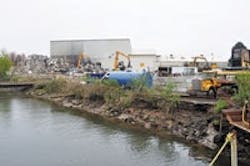About the author:
Calvin Noling, P.E., is president and CEO of StormwateRx. Noling can be reached at [email protected] or 503.233.4660.
The U.S. Environmental Protection Agency (EPA) and state regulatory agencies across the country, under the auspices of the Clean Water Act (CWA), have set water quality standards to ensure that surface water bodies are safe for uses such as fishing, swimming and aquatic species habitat. To help ensure these standards are met, industrial sites in the U.S. are required to comply with storm water discharge regulations that are designed to prevent pollutants on industrial sites from running off into local waterways. For many industrial sector businesses, understanding and complying with the storm water benchmarks set by various regulatory agencies can be confusing at best. But the cost of noncompliance can be considerable—both to the company’s bottom line and to the health of the environment.
Fortunately, there are best management practices (BMPs), including cost-effective storm water treatment BMPs, that can help industrial sites comply with and stay ahead of ever-tightening regulations. Implementing these BMPs can save industrial companies thousands, if not millions, of dollars in potential regulatory fines, consulting fees and legal costs. Meeting storm water benchmarks and exceeding environmental standards enables companies to stand out as environmentally conscious leaders in their communities, and provides reassurance that they are helping to keep local waterways clean and safe.
Water Quality Benchmarks
All industrial facilities should be mindful of the various water quality criteria and standards that exist for the bodies of water in their area receiving storm water runoff. StormwateRx has published a list of industrial storm water resources, outlining industrial pollutants by industry sector; providing a review of the regulatory process, enforcement and monitoring; and linking to benchmarks and requirements by state.
The development of storm water treatment BMPs has been driven by water quality-based benchmarks established by the EPA and state permitting agencies. These increasingly effective technologies enable facilities to significantly reduce and even eliminate a wide variety of pollutants—from petroleum hydrocarbons, oil and grease to dissolved heavy metals and toxic organic chemicals. Storm water treatment technologies include basic plug flow separators for oil and dirt separation; basic storm water filtration for removal of fine solids; enhanced storm water filtration for removal of dissolved metals, dissolved organics and phosphorus; and advanced polishing systems for removal of extremely small particles and low-level dissolved metals, bacteria and organic pollutants. Combinations of these technologies can be used in a treatment train configuration to remove almost any combination of storm water pollutants and concentrations to meet benchmarks and water quality goals.
The rule to follow when implementing storm water treatment BMPs is: 1) oil, 2) dirt, 3) dissolved pollutants, in this order. The design philosophy is that free oil must be removed first to protect downstream treatment BMPs such as filters that are optimized for removal of dirt. Filter performance will be impaired by the presence of oil. Furthermore, technologies that are optimized for removal of dissolved pollutants will operate less efficiently (and therefore more expensively) when particulates or dirt are not removed first. An optimized storm water treatment train will have an oil removal step, then a dirt removal step and finally a dissolved pollutant removal step.
In some cases, storm water treatment BMPs are installed when new industrial sites are being developed. But for most existing industrial facilities or those that are redeveloping, the site infrastructure already is in place and often predates the EPA’s CWA. These facilities must install retrofit storm water treatment systems that can be integrated to the existing grade of storm drains and catch basins. An advantage of retrofit storm water treatment systems is that they usually can be integrated with relatively noninvasive pumping systems. This allows intercepted storm water to be pumped to areas of the facility that are of lesser production value, where it can be treated and discharged as clean storm water through fewer outfalls.
In Summary
Over the next 20 years, the coupling of strict water pollution limits and water supply issues will drastically increase the incentive for industry to treat and reclaim their storm water runoff if their processes use water or treat and infiltrate storm water to recharge aquifers. Meeting today’s environmental regulations with flexible systems that can be upgraded as regulations change helps industrial companies ensure that their investment in storm water BMPs will continue to generate positive returns—for both the corporate bottom line and the health of the world’s water resources.
Download: Here
